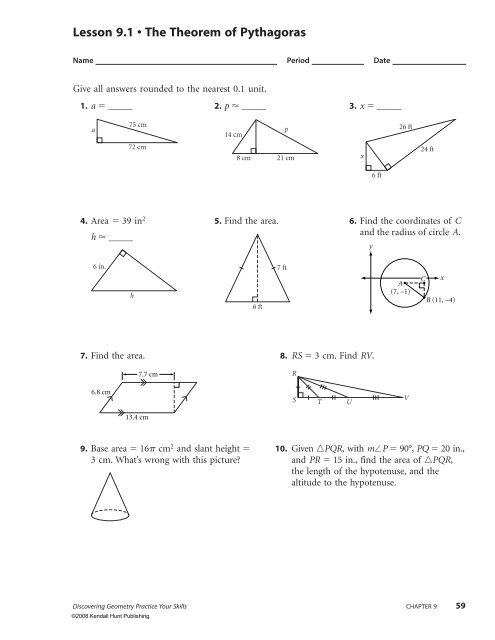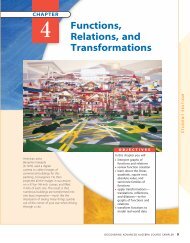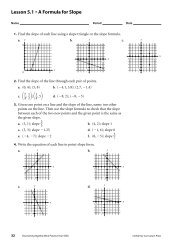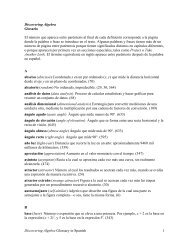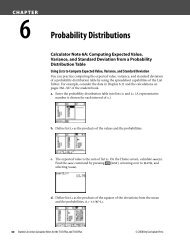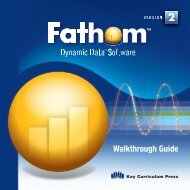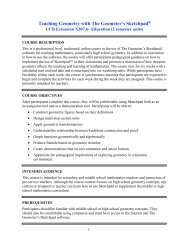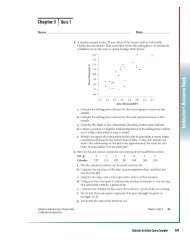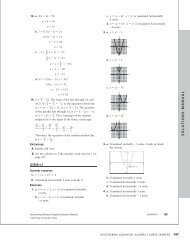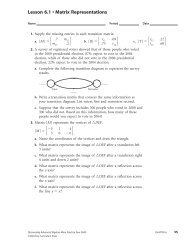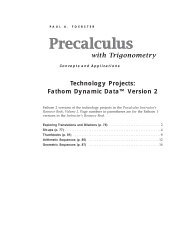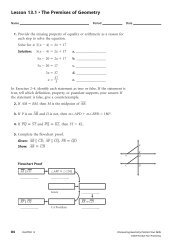Lesson 9.1 • The Theorem of Pythagoras
Lesson 9.1 • The Theorem of Pythagoras
Lesson 9.1 • The Theorem of Pythagoras
Create successful ePaper yourself
Turn your PDF publications into a flip-book with our unique Google optimized e-Paper software.
<strong>Lesson</strong> <strong>9.1</strong> <strong>•</strong> <strong>The</strong> <strong>The</strong>orem <strong>of</strong> <strong>Pythagoras</strong><br />
Name Period Date<br />
Give all answers rounded to the nearest 0.1 unit.<br />
1. a _____ 2. p _____ 3. x _____<br />
a<br />
4. Area 39 in2 5. Find the area. 6. Find the coordinates <strong>of</strong> C<br />
h _____<br />
and the radius <strong>of</strong> circle A.<br />
6 in.<br />
7. Find the area. 8. RS 3 cm. Find RV.<br />
6.8 cm<br />
75 cm<br />
72 cm<br />
7.7 cm<br />
13.4 cm<br />
9. Base area 16 cm 2 and slant height 10. Given PQR, with mP 90°, PQ 20 in.,<br />
3 cm. What’s wrong with this picture? and PR 15 in., find the area <strong>of</strong> PQR,<br />
the length <strong>of</strong> the hypotenuse, and the<br />
altitude to the hypotenuse.<br />
Discovering Geometry Practice Your Skills CHAPTER 9 59<br />
©2008 Kendall Hunt Publishing<br />
h<br />
14 cm<br />
6 ft<br />
p<br />
8 cm 21 cm<br />
7 ft<br />
R<br />
S T U<br />
x<br />
y<br />
6 ft<br />
26 ft<br />
A<br />
(7, –1)<br />
V<br />
24 ft<br />
C<br />
x<br />
B (11, –4)
<strong>Lesson</strong> 9.2 <strong>•</strong> <strong>The</strong> Converse <strong>of</strong> the Pythagorean <strong>The</strong>orem<br />
Name Period Date<br />
All measurements are in centimeters. Give answers rounded to the nearest<br />
0.01 cm.<br />
In Exercises 1–4, determine whether a triangle with the given side lengths<br />
is a right triangle.<br />
1. 76, 120, 98 2. 221, 204, 85 3. 5.0, 1.4, 4.8 4. 80, 82, 18<br />
5. Find the area <strong>of</strong> ABC. 6. What’s wrong with this picture?<br />
A<br />
C B<br />
7<br />
7. Find x. Explain your method. 8. Find the area <strong>of</strong> ABCD.<br />
C<br />
25 45<br />
7<br />
A B<br />
24 D x<br />
In Exercises 9–11, determine whether ABCD is a rectangle and justify your<br />
answer. If not enough information is given, write “cannot be determined.”<br />
9. AB 3, BC 4, and AC 6.<br />
10. AB 3, BC 4, DA 4, and AC 5.<br />
11. AB 3, BC 4, CD 3, DA 4, and AC BD.<br />
60 CHAPTER 9 Discovering Geometry Practice Your Skills<br />
A<br />
B<br />
5<br />
6.5<br />
95<br />
6<br />
D 22<br />
C<br />
6 8<br />
A<br />
32<br />
B<br />
D<br />
C<br />
©2008 Kendall Hunt Publishing
<strong>Lesson</strong> 9.3 <strong>•</strong> Two Special Right Triangles<br />
Name Period Date<br />
Give your answers in exact form unless otherwise indicated.<br />
All measurements are in centimeters.<br />
In Exercises 1–3, find the unknown lengths.<br />
1. a ______ 2. a ______, b ______ 3. a ______, b ______<br />
4. Find the area <strong>of</strong> rectangle 5. Find the perimeter and 6. AC _____, AB _____,<br />
ABCD. area <strong>of</strong> KLMN. and area ABC _____.<br />
A<br />
60<br />
a 14<br />
7. Find the area <strong>of</strong> an isosceles trapezoid if the bases have lengths 12 cm<br />
and 18 cm and the base angles have measure 60°.<br />
In Exercises 8 and 9, find the coordinates <strong>of</strong> C.<br />
8. y<br />
9.<br />
C<br />
16<br />
D C<br />
120<br />
(0, 1)<br />
(1, 0)<br />
x<br />
45 30<br />
K L<br />
10. Sketch and label a figure to demonstrate that 18 is<br />
equivalent to 32.<br />
x<br />
(12, 0)<br />
Discovering Geometry Practice Your Skills CHAPTER 9 61<br />
©2008 Kendall Hunt Publishing<br />
B<br />
12 3 b<br />
N<br />
a 60<br />
7<br />
M<br />
12<br />
C<br />
y<br />
210<br />
(0, 12)<br />
30<br />
a<br />
b<br />
C<br />
60<br />
45 30<br />
A B<br />
6
<strong>Lesson</strong> 9.4 <strong>•</strong> Story Problems<br />
Name Period Date<br />
1. A 20 ft ladder reaches a window 18 ft high. How far is the foot <strong>of</strong> the<br />
ladder from the base <strong>of</strong> the building? How far must the foot <strong>of</strong> the<br />
ladder be moved to lower the top <strong>of</strong> the ladder by 2 ft?<br />
2. Robin and Dovey have four pet pigeons that they train to race. <strong>The</strong>y<br />
release the birds at Robin’s house and then drive to Dovey’s to collect<br />
them. To drive from Robin’s to Dovey’s, because <strong>of</strong> one-way streets,<br />
they go 3.1 km north, turn right and go 1.7 km east, turn left and go<br />
2.3 km north, turn right and go 0.9 km east, turn left and go 1.2 km<br />
north, turn left and go 4.1 km west, and finally turn left and go 0.4 km<br />
south. How far do the pigeons have to fly to go directly from Robin’s<br />
house to Dovey’s house?<br />
3. Hans needs to paint the 18 in.-wide trim around the ro<strong>of</strong> eaves and<br />
gable ends <strong>of</strong> his house with 2 coats <strong>of</strong> paint. A quart can <strong>of</strong> paint<br />
covers 175 ft 2 and costs $9.75. A gallon can <strong>of</strong> paint costs $27.95. How<br />
much paint should Hans buy? Explain.<br />
18 in.<br />
9.5 ft<br />
28 ft<br />
42 ft<br />
18 ft<br />
4. What are the dimensions <strong>of</strong> the largest 30°-60°-90° triangle that will fit<br />
inside a 45°-45°-90° triangle with leg length 14 in.? Sketch your solution.<br />
62 CHAPTER 9 Discovering Geometry Practice Your Skills<br />
©2008 Kendall Hunt Publishing
<strong>Lesson</strong> 9.5 <strong>•</strong> Distance in Coordinate Geometry<br />
Name Period Date<br />
In Exercises 1–3, find the distance between each pair <strong>of</strong> points.<br />
1. (5, 5), (1, 3) 2. (11, 5), (5, 7) 3. (8, 2), (7, 6)<br />
In Exercises 4 and 5, use the distance formula and the slope <strong>of</strong> segments to<br />
identify the type <strong>of</strong> quadrilateral. Explain your reasoning.<br />
4. A(2, 1), B(3, 2), C(8, 1), D(3, 4) 5. T(3, 3), U(4, 4), V(0, 6), W(5, 1)<br />
For Exercises 6 and 7, use ABC with coordinates A(4, 14), B(10, 6), and<br />
C(16, 14).<br />
6. Determine whether ABC is scalene, isosceles, or equilateral. Find the<br />
perimeter <strong>of</strong> the triangle.<br />
7. Find the midpoints M and N <strong>of</strong> AB and AC, respectively. Find the<br />
slopes and lengths <strong>of</strong> MN and BC. How do the slopes compare? How<br />
do the lengths compare?<br />
8. Find the equation <strong>of</strong> the circle with center (1, 5) and radius 2.<br />
9. Find the center and radius <strong>of</strong> the circle whose equation is x 2 (y 2) 2 25.<br />
10. P is the center <strong>of</strong> the circle. What’s wrong with this picture?<br />
A(4, 6)<br />
B(5, –5)<br />
P(10, 1)<br />
C(16, –3)<br />
Discovering Geometry Practice Your Skills CHAPTER 9 63<br />
©2008 Kendall Hunt Publishing<br />
y<br />
x
<strong>Lesson</strong> 9.6 <strong>•</strong> Circles and the Pythagorean <strong>The</strong>orem<br />
Name Period Date<br />
In Exercises 1 and 2, find the area <strong>of</strong> the shaded region in each figure. All<br />
measurements are in centimeters. Write your answers in terms <strong>of</strong> and<br />
rounded to the nearest 0.1 cm 2 .<br />
1. AO 5. AC 8. 2. Tangent PT , QM12, mP 30°<br />
A<br />
3. AP 63 cm. Radius <strong>of</strong> circle O 37 cm.<br />
How far is A from the circumference <strong>of</strong><br />
the circle?<br />
4. Two perpendicular chords with lengths 12.2 cm and 8.8 cm have a<br />
common endpoint. What is the area <strong>of</strong> the circle?<br />
5. ABCD is inscribed in a circle. AC is a diameter. If AB 9.6 cm,<br />
BC 5.7 cm, and CD 3.1 cm, find AD.<br />
6. Find ST. 7. <strong>The</strong> coordinate <strong>of</strong> point M is 3<br />
, <br />
2<br />
1 2<br />
.<br />
Find the measure <strong>of</strong> AOM.<br />
6<br />
O<br />
C<br />
O<br />
S<br />
30°<br />
R<br />
B<br />
T<br />
P<br />
3<br />
P<br />
M<br />
O<br />
S<br />
P<br />
(0, 1)<br />
O<br />
y<br />
T<br />
M<br />
A<br />
A<br />
x<br />
(1, 0)<br />
64 CHAPTER 9 Discovering Geometry Practice Your Skills<br />
Q<br />
©2008 Kendall Hunt Publishing
4. It is too late to change the area. <strong>The</strong> length <strong>of</strong> the<br />
diagonals determines the area.<br />
LESSON 8.4 <strong>•</strong> Areas <strong>of</strong> Regular Polygons<br />
1. A 696 cm 2 2. a 7.8 cm<br />
3. p 43.6 cm 4. n 10<br />
5. s 4 cm, a 2.8 cm, A 28 cm 2<br />
6. Possible answer (s will vary): s 3.1 cm, a 3.7 cm,<br />
A 45.9 cm 2<br />
7. Approximately 31.5 cm2 : area <strong>of</strong> square 36; area<br />
<strong>of</strong> square within angle 3<br />
8 36 13.5; area <strong>of</strong><br />
octagon 120; area <strong>of</strong> octagon within angle <br />
3<br />
8 120 45; shaded area 45 13.5 31.5 cm2 LESSON 8.5 <strong>•</strong> Areas <strong>of</strong> Circles<br />
1. 81 cm 2 2. 10.24 cm 2 3. 23 cm<br />
4. 324 cm 2 5. 191.13 cm 2 6. 41.41 cm<br />
7. 7.65 cm 2 8. 4.90 cm 2 9. 51.3 cm 2<br />
10. 33.5 or 33.6 cm 2<br />
11. (64 128) square units<br />
12. 25 cm 2<br />
LESSON 8.6 <strong>•</strong> Any Way You Slice It<br />
1. 25<br />
<br />
12<br />
cm2 6.54 cm2 2. 32<br />
<br />
3<br />
cm2 33.51 cm2 3. 12 cm2 37.70 cm2 4. (16 32) cm 2 18.27 cm 2<br />
5. 13.5 cm 2 42.41 cm 2<br />
6. 10 cm 2 31.42 cm 2<br />
7. r 10 cm 8. x 135° 9. r 7 cm<br />
LESSON 8.7 <strong>•</strong> Surface Area<br />
1. 136 cm 2 2. 240 cm 2 3. 558.1 cm 2<br />
4. 796.4 cm 2 5. 255.6 cm 2 6. 356 cm 2<br />
7. 468 cm 2 8. 1055.6 cm 2<br />
9. 1 sheet: front rectangle: 3 1 1<br />
<br />
2 41 ;<br />
2 back rectangle:<br />
3 2 1<br />
<br />
2 71<br />
2 ; bottom rectangle: 3 2 6;<br />
side trapezoids: 22 8; total 26 ft2 <br />
2<br />
.<br />
Area <strong>of</strong> 1 sheet 4 8 32 ft 2 . Possible pattern:<br />
LESSON <strong>9.1</strong> <strong>•</strong> <strong>The</strong> <strong>The</strong>orem <strong>of</strong> <strong>Pythagoras</strong><br />
1. a 21 cm 2. p 23.9 cm<br />
3. x 8 ft 4. h 14.3 in.<br />
5. Area 19.0 ft 2 6. C(11, 1); r 5<br />
7. Area 49.7 cm 2 8. RV 15.4 cm<br />
9. If the base area is 16 cm 2 , then the radius is 4 cm.<br />
<strong>The</strong> radius is a leg <strong>of</strong> the right triangle; the slant<br />
height is the hypotenuse. <strong>The</strong> leg cannot be longer<br />
than the hypotenuse.<br />
10. Area 150 in 2 ; hypotenuse QR 25 in.; altitude to<br />
the hypotenuse 12 in.<br />
LESSON 9.2 <strong>•</strong> <strong>The</strong> Converse <strong>of</strong> the Pythagorean <strong>The</strong>orem<br />
1. No 2. Yes 3. Yes 4. Yes<br />
5. Area 21.22 cm 2<br />
6. <strong>The</strong> top triangle is equilateral, so half its side length<br />
is 2.5. A triangle with sides 2.5, 6, and 6.5 is a right<br />
triangle because 2.5 2 6 2 6.5 2 . So, the angle<br />
marked 95° should be 90°.<br />
7. x 44.45 cm. By the Converse <strong>of</strong> the Pythagorean<br />
<strong>The</strong>orem, ADC is a right triangle, and ADC is a<br />
right angle. ADC and BDC are supplementary,<br />
so BDC is also a right triangle. Use the<br />
Pythagorean <strong>The</strong>orem to find x.<br />
Discovering Geometry Practice Your Skills ANSWERS 109<br />
©2008 Kendall Hunt Publishing<br />
1_<br />
1<br />
2<br />
ft<br />
1_<br />
2<br />
2<br />
ft<br />
Side<br />
Side<br />
2 ft<br />
1_<br />
2<br />
2<br />
ft<br />
1_<br />
1<br />
2<br />
ft<br />
2 1 2 1 1 2 <br />
Front<br />
Back<br />
1_<br />
1<br />
2<br />
ft<br />
1_<br />
2<br />
2<br />
ft<br />
2 ft<br />
Left over<br />
3 ft<br />
Bottom<br />
3 ft 3 ft<br />
2 ft
8. 129.6 cm 2<br />
9. No. Because AB 2 BC 2 AC 2 , B <strong>of</strong> ABC is<br />
not a right angle.<br />
10. Cannot be determined. <strong>The</strong> length <strong>of</strong> CD is<br />
unknown. One possible quadrilateral is shown.<br />
A<br />
11. Yes. Using SSS, ABC BAD CDA <br />
DCB. That means that the four angles <strong>of</strong> the<br />
quadrilateral are all congruent by CPCTC. Because<br />
the four angles must sum to 360° and they are all<br />
congruent, they must be right angles. So, ABCD is<br />
a rectangle.<br />
LESSON 9.3 <strong>•</strong> Two Special Right Triangles<br />
1. a 142 cm<br />
2. a 12 cm, b 24 cm<br />
3. a 12 cm, b 63 cm<br />
4. 643 cm 2<br />
5. Perimeter 32 62 63 cm;<br />
area 60 183 cm 2<br />
6. AC 302 cm; AB 30 303 cm;<br />
area 450 4503 cm 2<br />
7. 453 cm2 8. C1 3<br />
, 2 2<br />
9. C(63, 6)<br />
10. Possible answer:<br />
2<br />
2<br />
18<br />
22<br />
6 6 8<br />
4.8<br />
LESSON 9.4 <strong>•</strong> Story Problems<br />
2<br />
D<br />
B C<br />
3<br />
32 10<br />
2<br />
3<br />
1. <strong>The</strong> foot is about 8.7 ft away from the base <strong>of</strong> the<br />
building. To lower it by 2 ft, move the foot an<br />
additional 3.3 ft away from the base <strong>of</strong> the building.<br />
2. About 6.4 km<br />
3. 149.5 linear feet <strong>of</strong> trim must be painted, or<br />
224.3 feet2 . Two coats means 448.6 ft2 <strong>of</strong> coverage.<br />
Just over 2 1<br />
<br />
2 quarts <strong>of</strong> paint is needed. If Hans buys<br />
3 quarts, he would have almost 1<br />
<br />
2 quart left. It is<br />
slightly cheaper to buy 1 gallon and have about<br />
1 1<br />
<br />
2 quarts left. <strong>The</strong> choice is one <strong>of</strong> money versus<br />
conserving. Students may notice that the eaves<br />
extend beyond the exterior walls <strong>of</strong> the house and<br />
adjust their answer accordingly.<br />
14<br />
28<br />
4. 14 in., in. 8.08 in., in. 16.17 in.<br />
3<br />
3<br />
LESSON 9.5 <strong>•</strong> Distance in Coordinate Geometry<br />
1. 10 units 2. 20 units 3. 17 units<br />
4. ABCD is a rhombus: All sides 34,<br />
slope AB 3<br />
5 , slope BC 3<br />
,<br />
5 so B is not<br />
a right angle, and ABCD is not a square.<br />
5. TUVW is an isosceles trapezoid: TU and VW <br />
have slope 1, so they are parallel. UV and TW <br />
have length 20 and are not parallel<br />
(slope UV 1<br />
,<br />
2 slope TW 2).<br />
6. Isosceles; perimeter 32 units<br />
7. M(7, 10); N(10, 14); slope MN 4<br />
3 ; slope BC 4<br />
3 ;<br />
MN 5; BC 10; the slopes are equal;<br />
MN 1<br />
2 BC.<br />
8. (x 1) 2 (y 5) 2 4 9. Center (0, 2), r 5<br />
10. <strong>The</strong> distances from the center to the three points<br />
on the circle are not all the same: AP 61,<br />
BP 61, CP 52<br />
110 ANSWERS Discovering Geometry Practice Your Skills<br />
0.4 km<br />
14<br />
30<br />
4.1 km<br />
1.7 km<br />
3.1 km<br />
1.2 km<br />
0.9 km<br />
2.3 km<br />
©2008 Kendall Hunt Publishing
LESSON 9.6 <strong>•</strong> Circles and the Pythagorean <strong>The</strong>orem<br />
1. (25 24) cm 2 , or about 54.5 cm 2<br />
2. (723 24) cm 2 , or about 49.3 cm 2<br />
3. (5338 37) cm 36.1 cm<br />
4. Area 56.57 cm 177.7 cm 2<br />
5. AD 115.04 cm 10.7 cm<br />
6. ST 93 15.6 7. 150°<br />
LESSON 10.1 <strong>•</strong> <strong>The</strong> Geometry <strong>of</strong> Solids<br />
1. oblique 2. the axis 3. the altitude<br />
4. bases 5. a radius 6. right<br />
7. Circle C 8. A 9. AC or AC<br />
10. BC or BC 11. Right pentagonal prism<br />
12. ABCDE and FGHIJ<br />
13. AF, BG, CH , DI , EJ <br />
14. Any <strong>of</strong> AF, BG, CH , DI , EJ or their lengths<br />
15. False. <strong>The</strong> axis is not perpendicular to the base in<br />
an oblique cylinder.<br />
16. False. A rectangular prism has six faces. Four are<br />
called lateral faces and two are called bases.<br />
17. True<br />
18.<br />
19.<br />
LESSON 10.2 <strong>•</strong> Volume <strong>of</strong> Prisms and Cylinders<br />
1. 232.16 cm 3 2. 144 cm 3<br />
3. 415.69 cm 3<br />
4. V 4xy(2x 3), or 8x2y 12xy<br />
5. V 1<br />
4 p2h 6. V 6 1<br />
2 x2y 7. 6 ft3 LESSON 10.3 <strong>•</strong> Volume <strong>of</strong> Pyramids and Cones<br />
1. 80 cm 3 2. 20<strong>9.1</strong>4 cm 3 3. 615.75 cm 3<br />
4. V 840x 3 5. V 8<br />
3 a2 b 6. V 4xy 2<br />
7. A: 128 cubic units, B: 144 cubic units.<br />
B is larger.<br />
8. A: 5 cubic units, B: 5 cubic units.<br />
<strong>The</strong>y have equal volumes.<br />
9. A: 9x cubic units, B: 27x cubic units. B is larger.<br />
LESSON 10.4 <strong>•</strong> Volume Problems<br />
1. 4.4 cm 2. 1728 in 3<br />
3. 24 cans; 3582 in 3 2.07 ft 3 ; 34.6%<br />
4. 2000.6 lb (about 1 ton)<br />
5. Note that AE AB and EC BC. V 8<br />
3 cm3 ;<br />
SA (8 42) cm2 13.7 cm2 6. About 110,447 gallons<br />
7. 57 truckloads<br />
LESSON 10.5 <strong>•</strong> Displacement and Density<br />
All answers are approximate.<br />
1. 53.0 cm 3 2. 7.83 g/cm 3<br />
3. 0.54 g/cm 3 4. 4.94 in.<br />
5. No, it’s not gold (or at least not pure gold). <strong>The</strong><br />
mass <strong>of</strong> the nugget is 165 g, and the volume is<br />
17.67 cm 3 , so the density is 9.34 g/cm 3 . Pure gold<br />
has density 19.3 g/cm 3 .<br />
LESSON 10.6 <strong>•</strong> Volume <strong>of</strong> a Sphere<br />
1. 288 cm 3 , or about 904.8 cm 3<br />
2. 18 cm 3 , or about 56.5 cm 3<br />
3. 72 cm3 , or about 226.2 cm3 4. 28<br />
<br />
3<br />
cm3 , or about 29.3 cm3 5. 432 cm3 , or about 1357.2 cm3 6. 304<br />
<br />
3<br />
cm3 , or about 318.3 cm3 7. 11 cm<br />
8. 2250 in 3 7068.6 in 3<br />
9. 823.2 in 3 ; 47.6% 10. 17.86<br />
LESSON 10.7 <strong>•</strong> Surface Area <strong>of</strong> a Sphere<br />
1. V 1563.5 cm 3 ; S 651.4 cm 2<br />
2. V 184.3 cm 3 ; S 163.4 cm 2<br />
Discovering Geometry Practice Your Skills ANSWERS 111<br />
©2008 Kendall Hunt Publishing


